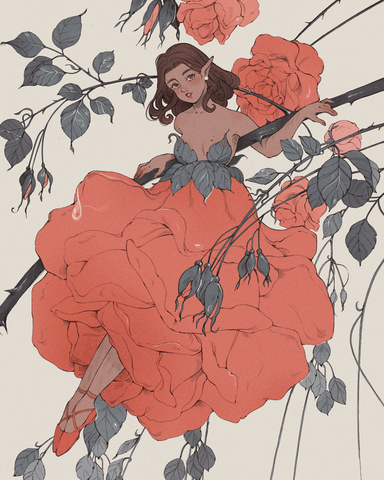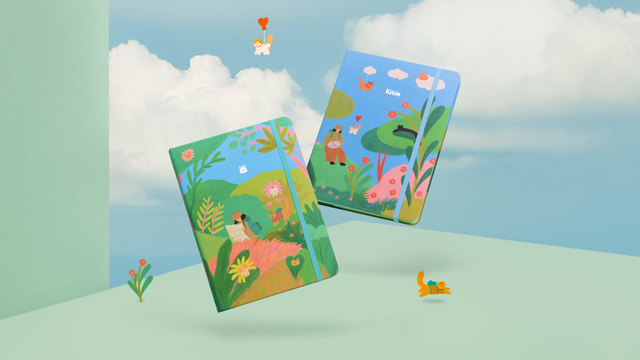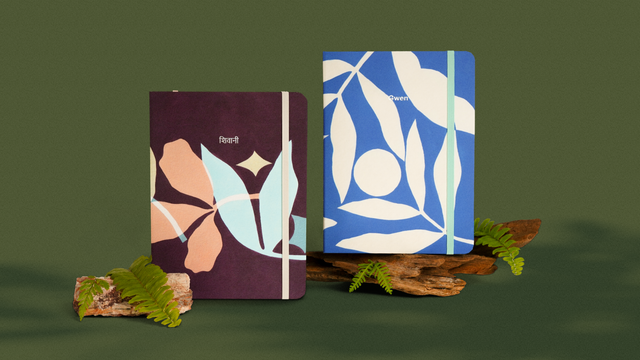
In a world where one can get caught up in the labels that often seem to divide us, we must not forget that within each of our diverse and unique identities, akin to a palette, each of us represents a colour waiting to be brought together and made into something beautiful.
With that in mind, we’ve curated a series of stories in hopes of inspiring our young readers to not only embrace their own individual identities but to also embrace and accept the identities of others.
Read on to discover what these five artists have to say about their experiences–
***

As a creator, how much does your identity translate into your work?
My identity has essentially shaped what I’m now most known for in my art. Once I began to explore more about who I am as a person and what inspires me, the ideas came much more easily. There are parts of myself that I never got to show or thoroughly feel when I was younger, so I now get to portray that in my work.
Even though I identify as bi, many of the relationships I draw don’t include men. I’ve had far less time in my life to reflect on the part of me who loves women and nonbinary people, so I’ve been living vicariously through my art to give that part of me some love and attention. In my webcomic Realta, my main character also goes by she/they pronouns just like I do.

How has your environment challenged you in terms of creating art?
II still live with my parents who are flat out homophobic and very conservative. They know nothing about my comic or most of the art that I make, and sometimes it gets pretty stressful to keep hiding it. I always have this underlying anxiety that they’ll find out and my life will be ruined. I don’t hate them though, and I don’t want them to hate me for who I am. It’s just something I’ll have to keep living with. On the plus side, I’m hoping to move out next year since my art career has been doing quite well!

What do you hope young artists like you will feel reading this?
There are so many people who will support you. There is nothing wrong with you. You deserve people and a career that won’t make you feel like you’re burning alive. Follow your passions, and take breaks when you need them, because your well being should come first.
You might cry because life will always get stressful, but remember that good and bad things will come and go like waves. Just keep going, and you’ll be just fine.
***

As a creator, how much does your identity translate into your work?
Very heavily! I’m Asian, nonbinary, and a butch lesbian, and the bulk of my personal work consists of my queer Asian characters from an illustrated novel I’m currently in the process of planning out.
My work and my identity are inseparable. I want to be seen. I will make people see and acknowledge me through my bright colors and lesbian and transgender themes, and I will not give anyone who is uncomfortable with my identity the luxury of minimizing myself because I’ve already done that my whole life. Let me out!!

How has your environment challenged you in terms of creating art?
One thing I’ve never been able to shake off is a profound sense of internalized shame, which I feel is unfortunately relatable for many queer people, especially those of us who grew up in cultures that strongly center around it, doubled by the otherness of being brought up in a profoundly white and binary-heavy society.
I love creating art and stories, it’s what I feel I was born to do. And I’m also constantly ashamed of it. Ashamed of my old work and who I used to be. Ashamed of my mistakes, of being “too much” (too gay), of being too “me.” Ironically, at the same time, the burning desire to show who I really am and constantly overcoming myself is the core of what drives my art.
It’s like my desire to be true to myself is always at odds with how I was raised to see myself, and, suffice to say, that view is not kind. But at the end of the day, I want to love myself. And I do, because of the people who love me.
I am who I am because of the people who have afforded me kindness and the space to grow, and no matter how much shame I carry, their kindness will always, always mean more to me than the shame that threatens to destroy me.

What do you hope young artists like you will feel reading this?
I hope you feel fired up! It’s cliche, but I want us as queer artists to know how important we are, because it’s true! No one is doing it like us. Our voice, our art, our very existence: we are so important despite all the voices that try to minimize us.
We are made to love and be loved, to help each other, to uplift each other, to show the world we will stand strong and not back down no matter how we are painted as shameful, dirty, unworthy.
And this goes double for queer people of color! Whether you choose to depict your gender, sexuality, ethnicity, and culture in your art or not, whether you choose to use art as a medium for joy or pain, your voice is so invaluable and priceless and absolutely no one can take that away from you. Your art is yours, your story is yours, and if you choose to tell it, I promise there will be people out there to love it, to love you.
***

As a creator, how much does your identity translate into your work?
It wasn’t until my mid-20s that I felt comfortable enough to call myself a lesbian in both public and private, which coincided with when I started exploring sapphic themes in my work. As a Hungarian-Peruvian lesbian, my identity affects both my interests and experiences. My artwork is a physical extension of that. I’m a POC girl who loves other girls - I’d like to think you can tell that just by looking at my art!

How has your environment challenged you in terms of creating art?
It’s very difficult to find any representation of my experiences especially in my favorite genres/themes, such as in vintage art, fairytales and fantasy.
There’s so much negativity both online and off about my sexuality, my ethnicity and my outward presentation, so it took me a long time to unlearn all of my internalized homophobia and self-hate.
Surrounding myself with supportive friends who love me for who I am definitely has helped me believe in myself and my dreams. Now, I feel that the best thing I can do as an artist is to create my own representation.

What do you hope young artists like you will feel reading this?
I love the term “sapphic”. It's a word that means “attraction to women or woman-aligned people”. I love using this word to describe my artwork not only because of how lovely it sounds, but also because it can be so inclusive.
My artwork is heavily based on my experiences, but the viewer will always try to relate it back to themselves. I love to be able to make my viewers see themselves in my work when I wasn’t able to. It’s very lonely when you don’t see yourself reflected anywhere. That’s why representation is so important!
***

As a creator, how much does your identity translate into your work?
Being true to myself is the most important rule I have when it comes to making art. I love telling stories through my art based on my feelings and emotions, and it's safe to say that my identity as a person plays a big part in that.
Being gay and non-binary, I find a lot of comfort in drawing art that allows me to express both my sexual and gender identity. I am still exploring and finding out more about myself as a person, and having art as a guide for exploration makes the process so much more comforting for me.

How has your environment challenged you in terms of creating art?
Self expression is something that's very important to me. Unfortunately, I live in a very religious household and I do not have the safe space to freely be who I really am. Don’t get me wrong, I have very loving and caring parents, but it's difficult to live through daily life when you have to live in the closet and hide under a crushing facade of normality.
I take extra precautions to hide that side of me from my family and friends by keeping most of my art hidden from them, which is heartbreaking as art is my life and soul. At times I fear my safe space being compromised and I would have to live and create art in fear, therefore I am eternally grateful for the community and friends that accept and support me for who I am.
A lot of my artworks feature a space that is safe, comfortable and happy; feelings that I hope others would feel when looking at my art. My current physical environment may not be the best for my art, but I try my best to not let it stop me from creating anything I want, even perhaps a better place for myself. After all, I can create anything in art, including my own worlds.

What do you hope young artists like you will feel reading this?
You're at your best when you enjoy what you create. Make sure that the art you create is something you love and is for yourself. With that being said, be proud of who you are and don't ever feel bad about being yourself. There will be people out there that will try their best to bring you down for that, and you should never let them tell you who to be or how to feel.
Things might be tough for now, but it will get better. It's been a huge struggle for me to overcome my current situation and it has negatively affected my art and mental health, but regardless I am trying my best to stay afloat. One day, I'll be able to show who I am and be proud of it! Happy Pride Month!
***

As a creator, how much does your identity translate into your work?
I’d like to believe it’s difficult to look at my work and not think someone who was a femme lesbian made it. There’s so much of myself in everything that I create - how I see myself, how I see other lesbians, how much I love being a lesbian. My relationship to womanhood and lesbianism is in everything that I make.
It’s nice feeling like my art is not just inseparable but also directly stemmed from being a non-binary lesbian. There’s so much intersectionality in my identity, and every aspect of who I am results in this multi-faceted gem that informs my art. I could list it all, probably - I am nonbinary, I am a lesbian, I am femme, I am an immigrant - but at the end of the day, I am just another member of the LGBT+ community.

How has your environment challenged you in terms of creating art?
Since moving to Burlington, Vermont, I’ve been able to really explore more of myself and my identity, and that’s actually taken me away from creating for a long while. And that was hard - I never lost the desire to make art, but I couldn’t always figure out how to marry myself to the work I created. So I did take a step back, and I did take a good look at myself.
There’s so much negativity both online and off about my sexuality, my ethnicity and my outward presentation, so it took me a long time to unlearn all of my internalized homophobia and self-hate.
I’ve done a lot of research into the lesbian bar culture that, now, feels so long ago. I’ve somehow been able to feel truly connected to it and let it color my world, but I had to allow myself that exploration. I had to allow myself to examine how being a woman of color affected my view on gender; How growing up speaking a language with only gender neutral pronouns affected the way I called myself “woman” and used she and they interchangeably. I had to allow myself to examine what it meant to me to be a woman who loved other women, whose experiences with womanhood overlapped with my own experiences. I allowed myself all of that exploration, and more, and I have been so much better for it.
I feel more excited to create art again, and I feel even more excited to create art while knowing more of myself. It seems like every piece I do is somehow made through the lens of a femme lesbian - which is exactly how I’d like to keep it!

What do you hope young artists like you will feel reading this?
I hope that younger artists allow themselves the time to explore themselves. Figuring out who you are should never be the goal, in my opinion, because each person is fluid and changes throughout their life. Finding a label and identity to claim is a great thing, and for many people, can be extremely freeing, but I want those younger than me to remember you are never “one thing.”
The LGBT+ community has always been that - a community. A group of people who vary so much yet share such similar and overlapping experiences. Many of us have a relationship to gender that is intertwined with our sexuality, and many of us have our identities colored by many other things, like our race or our immigration status, and even the culture of where we were raised.
To allow yourself the freedom of exploration is oftentimes just as liberating as coming home to an identity. People are many things, and Pride, at its core, is about celebrating the different ways people can “be.”
-
With that said, we’d like to thank these artists for taking the time out of their busy schedules to speak about their experiences and challenges that they’ve endured.
With each story that we present, we hope that you take inspiration from these unique perspectives and strive to do the same, regardless of the adversities that you may face.
Not only that, in conjunction with our Palette Parade campaign, we’ve released a new cover titled ‘Prism’ to celebrate the diversities that make up the everyday community!
With every purchase in the month of June, 40% of sales will be donated to the SEED Foundation and the It Gets Better Project. Read more about it here.
Do you also have a story about your challenges and what perspectives you might bring to the table? Let us know in the comments!




